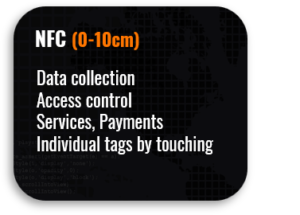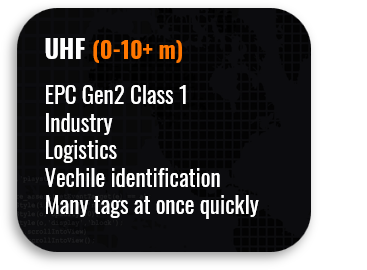What is RFID?
RFID (Radio Frequency Identification) is a general term for techniques operating on radio frequencies. RFID is an automatic identification technology which enables data transfer between a tag and a reader without eye sight. Each tag may carry their unique identifying number and have re-writable memory. A tag can be programmed to store information about the product, manufacturing process, time, location etc. An RFID system consists of tags and reader devices as well as back-end system for feeding and reading information. The devices can be anything from small and compact module boards to vehicle accessible gates. Back-end system — software solution — gathers the information and includes required connections to databases etc. To implement an RFID solution is nowadays more likely to be a software project.
There are several types of RFID tags and many protocols. If the tag is equipped with a battery it is called an active tag, meaning longer read range and higher unit price. Lower cost passive tags do not have own power source, but the energy for data transfer is received from the reader. Both passive and active tags can have writable and re-writable memory.
What is NFC?

NFC (Near Field Communication) stands for a short-range wireless connectivity technology that evolved from a combination of existing contactless identification and interconnection technologies. It is aimed especially for consumer solutions and payments used with NFC enabled mobile devices. When a reader device, like a mobile phone, gets close enough of the tag, it reacts automatically and opens e.g. a web page that’s encoded on the tag. Most of the features that you can encode on an NFC tag function without installing any applications on mobile device.
What is HF?

HF (High Frequency) stands for RFID frequency band (13,56 MHz), which is used especially for item level solutions like document management and library solutions. Protocols include ISO 15693 and ISO 14443-A/B. The advantage of HF frequencies compared to UHF is that the signal can go through objects that have a significant water content, like humans. Due to the quite short reading range its also easy to use on industrial surroundings: long reading distances are more vulnerable for the disruptions caused by metal surfaces.
What is UHF?

UHF (Ultra High Frequency) means RFID frequency band (860 – 960 MHz) which is used especially for logistics’ identification solutions. UHF is suitable for quick identification of large quantities of products and goods. Protocols include EPC Gen 2 (ISO 18000-6C) and ISO 18000-6B.